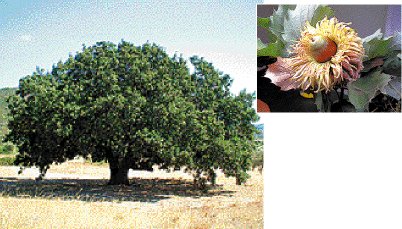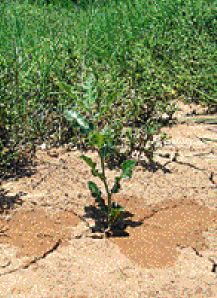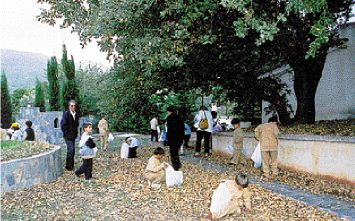 |
||
|
From Little Acorns |
||
|
By Jennifer Gay An environmental society is working to reforest the hills of Attica withValonia Oak, creating beautiful, fire-resistant and drought-tolerant woodlands on barren land ON THE island of Kea, just one hour by boat from the port of Lavrio in southern Attica, there remains a sizeable woodland of Valonia Oak (Quercus macrolepis - syn Quercus aegilops). Valonia Oak woodlands |
 Valonia Oak is distinctive by its decorative acorn cups (inset) |
|
| were once widespread throughout the eastern Mediterranean (like that other magnificent native, the Holm Oak, Quercus ilex). A deciduous or semi-evergreen tree, it is distinctive from other oaks by virtue of the huge and decorative acorn cups - these may be 4cm across, with pretty "moss-like" re-curved spreading scales. The acorns make very good fodder for wild and domestic animals (notably pigs, sheep and goats), while the cups and scales were traditionally used, powdered or liquidised, for tanning leather. Though some woodlands still remain in southern Albania, Greece (particularly Aitoloakarnania and the islands), Turkey, Lebanon, Jordan, Israel and Syria, the Valonia Oak's extent has decreased considerably over the centuries. The Aitoloakarnania woodland is the largest remaining in the Balkans. The reasons for its historical decline are many: the oak became less valuable as the demand for acorns for fodder and cups for tanning fell, thus making it particularly vulnerable to systematic felling as a way to increase land for cultivation. Naturally, the Valonia Oak forms open, sparse woodland with a low-production density per strema compared with other timber. For this characteristic, it has suffered - the forestry authority has rarely (if ever?) favoured it as a tree to plant. However, it is a tree of great value - like many oaks, it is rather majestic in appearance when mature, the branches spreading wide and the leaves deeply divided - shiny dark green above and grey-green velvety below. Oaks have inspired writers and poets through the ages. Theofanis Mentzos wrote on his visit to an oak forest in Vyssani, Ioannina, "Prophetic trees: the breath of God passes through their foliage. You think you can hear metaphysical, melodious voices...reverent revelations of the will of God. A strange excitement grips you." The tree is also known as a haven for biodiversity, providing habitat for a myriad of creatures among its branches and around its base. And, being very deep rooted (the roots may reach up to 10 metres down) nor containing flammable resins, the Valonia Oak is also remarkably resistant to both storms and fire. Perhaps best of all, it is very drought tolerant, requiring little water for establishment. With so much in its favour, it thus seems surprising that the tree is not more widely planted. |
||
Luckily, the Valonia Oak has found a champion in the form of Iris Theodoridis, a member of the Greek Society for the Protection of Nature. She recognises the natural benefits and beauty of this tree and passionately supports the value of sowing seed. She also acknowledges that re-establishing this once-distinctive species of the Balkans and the east Mediterranean can play an important role not only re-forestation but also in tourism, creating aesthetic woodlands on barren hillsides. Theodoridis has found that the easiest and most cost-effective way to propagate the Valonia Oak is by directly sowing the acorns into the ground. She has also planted young saplings (7-10 months old) with good results. Saplings are best grown in biodegradeable pots which do not need to be removed on planting - thus the vulnerable hairy side roots are protected. Planting saplings, however, requires more skill and |
 Oakling saplings need plenty of water |
|
| time - not only do the saplings need to be cared for pre-planting, but they must be watered for at least one year after planting. This obligation is negated when the seeds are directly sown into the ground; seedlings established in this way also seem to adapt better and faster to their habitat and the oaks grow with similar success rates to their naturally distributed counterparts. Direct sowing creates far less disturbance to the ground thus avoiding possible soil erosion and disturbance of natural vegetation and regeneration. And with supervision, planting acorns is a very easy task, even fun, especially for young children. |
||
The Society of Friends of the Valonia Oak and the Environment, of which Theodoridis is a member, has encouraged volunteer groups and schools to sow acorns on the mountains of Attica since 1999 - Pendeli, Ymittos and Parnitha have all benefited from this activity. The acorns mature and fall to the ground between September and November, and are collected immediately so that they are not eaten by animals. The seeds are kept safely in a mixture of humid sand and soil until they can be sown. The only tool used is a wooden 'spike' with which holes are made about 15cm deep. Good, |
 Children gathering acorns |
|
|
humus-rich soil is placed in the hole and the acorns are sown at a depth of 2-3cm. As the saplings develop, they are pruned to encourage them to grow faster. Watershoots at the base of the trunk and some side shoots are removed. Gardeners' queries SOMETHING is eating my dwarf Dianthus! They are making new buds but these turn brown and fail to open. Inspection shows the centre of the buds has been eaten away by something. The leaves too have round brownish patches where something has taken a bite out of them. I have tried the Fairy Liquid spray (with a drop of chemical) but with only moderate success. I thought it might be ants but I see no sign of any. Can you shed any light as to what insect may be the culprit and suggest any alternative (and preventative) treatment? It sounds as if your Dianthus (Pinks or Carnations) may have been attacked by the tortrix moth caterpillar (Cacoecimorpha pronubana). Did you notice any of the leaves being bound together by fine silky threads, or perhaps one leaf folded over on itself, attached by threads? These caterpillars graze on the inner surface of leaves and flower buds, causing the remaining tissue to dry up and turn brown. They are up to 2cm long and generally dark green with brown heads. Because the caterpillars are concealed within their hiding places they are difficult to reach with insecticides. Squeeze bound-up leaves/flower buds to crush the caterpillars. If the problem is serious spray affected plants with Bacillus thuringiensis. Dianthus are a little problem-prone - they suffer from aphids, thrips, fungal leaf spots and rusts - all may come into play during the stressful, hot, dry summer conditions. If you have a gardening question for Jennifer Gay, send it to gardening@dolnet.gr and she will answer one question each week. |
||
|
|
||
|
Perfect pot plant |
 |
|
|
Europe, W Asia and N Africa has small dark green leaves. There are many cultivars, notably 'Suffruticosa' which is compact and slow growing, especially good for pots. Box grows best in semi-shade, with some sun for part of the day, preferring fertile well-drained soil. Don't trim box exposed to full sun in high summer as the leaves may scorch.
|
||
|
|
||
(Posting Date 5 October 2006) HCS readers can view other excellent articles by this writer in the News & Issues and other sections of our extensive, permanent archives at the URL http://www.helleniccomserve.com./contents.html
All articles of Athens News appearing on HCS have been reprinted with permission. |
||
|
||
|
2000 © Hellenic Communication Service, L.L.C. All Rights Reserved. http://www.HellenicComServe.com |
||

